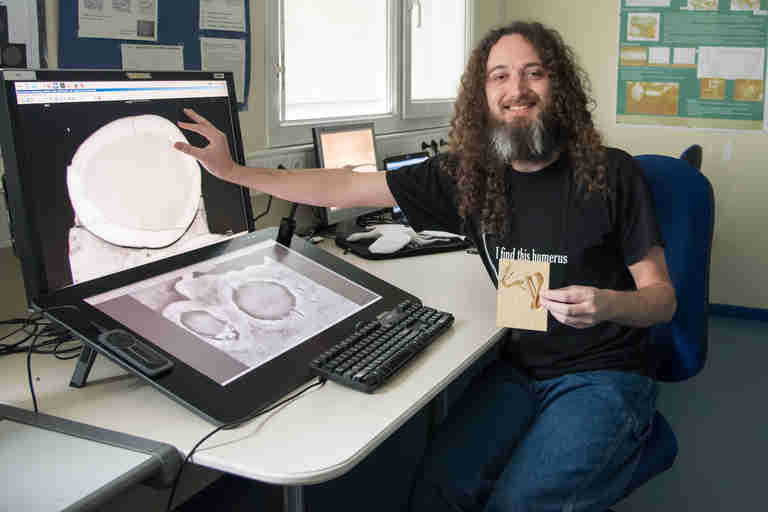 |
| Illustration of Archaeopteryx preying on a dragonfly |
The confusion was understandable. The iconic creature of the Late Jurassic 150 million years ago had feathers, wings, and measured 1.7 feet long — a little larger than the length of a green heron.
It could also fly, reports a new study. The findings, reported in the journal Nature Communications, provide the first direct comparative evidence that Archaeopteryx was an active flyer. They also strengthen the belief that this animal was not just a bird, but a dino-bird.
"Archaeopteryx is now considered the oldest free-flying member of the clade Avialae that includes not only modern birds but also all extinct dinosaurs more closely related to the house sparrow than to Deinonychus, the terrestrial hunter that was adopted by the Jurassic Park franchise as a model for their ferocious 'Velociraptor,'" lead author Dennis Voeten told Seeker.
"All birds therefore belong to Avialae, but not all avialans are considered birds anymore," added Voeten, who is a researcher at the European Synchrotron Radiation Facility (ESRF).
"Firstly, everybody who has enjoyed eating a whole chicken or turkey will recognize the flat bone protruding from its rib cage," Voeten said. "This is the keeled breastbone, or sternum, of the bird that supports large flight muscles, which we know as chicken fillet or turkey breast. Nearly all modern flying birds have such a prominent sternum, but this appears to have been absent in Archaeopteryx."
Secondly, the flight stroke of modern birds involves raising the wings well over the backbone during the upstroke, yet the shoulder joint of Archaeopteryx seems not to have allowed for this motion.
Thirdly, most muscles involved in both the upstroke and downstroke of modern birds attach to the keel of the sternum.
"For the downstroke," Voeten said, "this is not extraordinary. When we move our arms together, we use a broadly similar muscle arrangement. For the upstroke, however, birds have a specialized tendon that loops over the shoulder before attaching to the upside of the upper arm bone. This pulley system allows for the quick upstroke of modern birds but was absent in Archaeopteryx."
It therefore seemed at first like Archaeopteryx was incapable of significant flight, except perhaps for gliding.
Unconvinced of this conclusion, Voeten and his team turned the flight question around and focused, not on the skeletal conditions that could have allowed for certain motions, but rather on bones that would have "recorded" volancy.
Even this proved to be challenging because most Archaeopteryx fossils are preserved in and on limestone slabs from the German state of Bavaria. They are among the most valuable in the world. This is due to their state of preservation, age, and relevance to understanding other species. Invasive probing to reveal obscured or internal structures has therefore been discouraged over the years.
"Fortunately, today it is no longer necessary to damage precious fossils," said Paul Tafforeau, who was co-senior author of the paper with Sophie Sanchez. Both are ESRF scientists.
The scientists focused on the cross-sectional architecture of Archaeopteryx's limb bones, co-author Jorge Cubo of the Sorbonne University said. He and Voeten explained that limb bones evolve to cope with the stress of an individual's locomotion and provide informative clues on how the animal moved.
Additionally, they determined that the limb structure allies Archaeopteryx with modern birds that use incidental active flight to evade predators or to cross physical barriers, but that often exhibit a predominantly Earth-bound lifestyle.
The prehistoric dino-bird probably occupied an ecological niche somewhat similar to that of today's pheasants. It also possibly shared some similarities with the present-day secretary bird.
"The secretary bird is an African bird of prey with a predominantly terrestrial lifestyle, although it is much larger and has relatively much longer legs than Archaeopteryx," Voeten said.
Archaeopteryx's mode of flight was not identical to that of such modern birds.
"Archaeopteryx likely required a running start to take flight, whereas birds like pheasants and quails are capable of vertical takeoff,” Voeten explained. “In a scenario where early dinosaurian flight importantly contributes to fleeing behavior, vertical takeoff would bring an animal quicker outside the range of an earthbound predator than a running take-off would."
Based on the ancient dino-bird's shoulder girdle, the researchers believe that approximately the 2.2-pound Archaeopteryx had a flight stroke that was oriented forward and up, followed by a power stroke oriented rearward and down. The motion is midway between the grabbing abilities of small ancestral meat-eating dinosaurs, such as raptors, and the wing beat cycle of modern flying birds.
Once airborne, it is possible that Archaeopteryx could fly from anywhere between 66 feet and a mile. It could also probably fly in quick bursts.
At least one non-avian dinosaur appears to have exhibited a different form of flight. The enigmatic Yi qi, for example, sported bat-like wings that probably allowed it to glide. Yi qi, from China, also lived during the Late Jurassic.
"We feel our study supports that the evolution of dinosaurian flight was not simply a straight line towards the flight of modern birds, but involved an exotic diversity of alternative, experimental, and intermediate solutions that ultimately proved to be evolutionary dead-ends," Voeten said.
He added, "This illustrates that the diversity of locomotor strategies evolved in dinosaurs must have been larger than previously thought."
Read more at Seeker



No comments:
Post a Comment